Unit 9: Entrepreneurship and Small Business Management Formal Report
VerifiedAdded on 2022/12/28
|16
|4978
|35
Report
AI Summary
This formal report on Entrepreneurship and Small Business Management explores various aspects of entrepreneurial undertakings. It begins by defining entrepreneurship and categorizing different types, including small business, scalable start-up, social entrepreneurship, and large organization entrepreneurship, while also discussing typologies such as survival, lifestyle, controlled development, and dynamic growth undertakings. The report then delves into the similarities and differences between these various forms. Furthermore, it analyzes the impact of small and micro organizations on the economy, providing statistical data and insights into their significance, particularly in the UK. The report also identifies the abilities and attributes of successful entrepreneurs, contrasting them with business managers and examining the influence of entrepreneurial attributes on motivation and mentality. Finally, it evaluates the impact of background and experience on the success or failure of entrepreneurial ventures, using relevant examples to illustrate its points. The report concludes with a synthesis of the key findings and recommendations for fostering a thriving entrepreneurial ecosystem.

Formal Report
Paraphrase This Document
Need a fresh take? Get an instant paraphrase of this document with our AI Paraphraser

Table of Contents
INTRODUCTION...........................................................................................................................3
MAIN BODY..................................................................................................................................3
TASK 1............................................................................................................................................3
P1 Evaluation of several kinds of entrepreneurship undertaking and explanation of their
relation to categorization of entrepreneurship .........................................................................3
P2 Describe differences and similarities between entrepreneurial undertaking .......................6
TASK 2............................................................................................................................................7
P3 Understand and asses relevant information and statistical data to depict impact of small
and micro organisations on the economy...................................................................................7
P4 Significance of small enterprises and start up firms to the development of social economy9
TASK 3..........................................................................................................................................10
P5 Identification of abilities and attributes of prosperous entrepreneur which differ from
business managers.....................................................................................................................10
P6 Impact of entrepreneurial attributes on entrepreneurial motivation and mentality.............12
TASK 4..........................................................................................................................................13
P7 Evaluate impact of background and experience on growth or failure of entrepreneurship
with utilisation of suitable examples........................................................................................13
CONCLUSION.............................................................................................................................15
REFRENCES.................................................................................................................................16
INTRODUCTION...........................................................................................................................3
MAIN BODY..................................................................................................................................3
TASK 1............................................................................................................................................3
P1 Evaluation of several kinds of entrepreneurship undertaking and explanation of their
relation to categorization of entrepreneurship .........................................................................3
P2 Describe differences and similarities between entrepreneurial undertaking .......................6
TASK 2............................................................................................................................................7
P3 Understand and asses relevant information and statistical data to depict impact of small
and micro organisations on the economy...................................................................................7
P4 Significance of small enterprises and start up firms to the development of social economy9
TASK 3..........................................................................................................................................10
P5 Identification of abilities and attributes of prosperous entrepreneur which differ from
business managers.....................................................................................................................10
P6 Impact of entrepreneurial attributes on entrepreneurial motivation and mentality.............12
TASK 4..........................................................................................................................................13
P7 Evaluate impact of background and experience on growth or failure of entrepreneurship
with utilisation of suitable examples........................................................................................13
CONCLUSION.............................................................................................................................15
REFRENCES.................................................................................................................................16

INTRODUCTION
Entrepreneurship is defined as identification of business opportunities and the resultant
production of new economic tasks frequently through construction of business entity.
Entrepreneurship involves building and managing a commercial enterprise in order to generate
profit by taking calculated risks in the marketplace. Entrepreneur is person who builds new
organisation which utilises finance and labour to manufacture goods or services for achieving
profitability. The present report is based on the subject of Entrepreneurship and small business
management and involves description of various entrepreneurial undertaking. This report
includes differences and similarities between various entrepreneurial undertaking along with
impact of small business on the economy. Attributes of prosperous entrepreneurs and impact of
entrepreneurial psyche on entrepreneurial mentality is also discuses in this report. In addition to
this, effects of background and experience on development or failure of entrepreneurship are
provided in this report.
MAIN BODY
TASK 1
P1 Evaluation of several kinds of entrepreneurship undertaking and explanation of their relation
to categorization of entrepreneurship
Entrepreneurs need to constantly search for new ideas and aim to modify their business
operations so that it maintains profitability in ever-changing business environment.
Entrepreneurs aim to grow their business from humble foundation into a leading member of their
industry (Urban and Chantson, 2019) . Entrepreneurial undertakings are classified into various
categories which are mentioned below:
Small business entrepreneurship
This type of entrepreneurship is one of the most popular kind of entrepreneurial
undertaking. This type of enterprise has fewer resources and yearly revenue lower than large or
medium business entities. These kinds of organisation are controlled and managed by owners of
the organisation which include an individual, group or family. These enterprises generate low
profitability as they are not leading organisation in their sector or operate within a niche market
with low consumer base (Ahmed, Chandran and Klobas, 2017) . Small business entrepreneurship
are usually started by investment from the owner's finances and the owner has to suffer any
Entrepreneurship is defined as identification of business opportunities and the resultant
production of new economic tasks frequently through construction of business entity.
Entrepreneurship involves building and managing a commercial enterprise in order to generate
profit by taking calculated risks in the marketplace. Entrepreneur is person who builds new
organisation which utilises finance and labour to manufacture goods or services for achieving
profitability. The present report is based on the subject of Entrepreneurship and small business
management and involves description of various entrepreneurial undertaking. This report
includes differences and similarities between various entrepreneurial undertaking along with
impact of small business on the economy. Attributes of prosperous entrepreneurs and impact of
entrepreneurial psyche on entrepreneurial mentality is also discuses in this report. In addition to
this, effects of background and experience on development or failure of entrepreneurship are
provided in this report.
MAIN BODY
TASK 1
P1 Evaluation of several kinds of entrepreneurship undertaking and explanation of their relation
to categorization of entrepreneurship
Entrepreneurs need to constantly search for new ideas and aim to modify their business
operations so that it maintains profitability in ever-changing business environment.
Entrepreneurs aim to grow their business from humble foundation into a leading member of their
industry (Urban and Chantson, 2019) . Entrepreneurial undertakings are classified into various
categories which are mentioned below:
Small business entrepreneurship
This type of entrepreneurship is one of the most popular kind of entrepreneurial
undertaking. This type of enterprise has fewer resources and yearly revenue lower than large or
medium business entities. These kinds of organisation are controlled and managed by owners of
the organisation which include an individual, group or family. These enterprises generate low
profitability as they are not leading organisation in their sector or operate within a niche market
with low consumer base (Ahmed, Chandran and Klobas, 2017) . Small business entrepreneurship
are usually started by investment from the owner's finances and the owner has to suffer any
⊘ This is a preview!⊘
Do you want full access?
Subscribe today to unlock all pages.

Trusted by 1+ million students worldwide
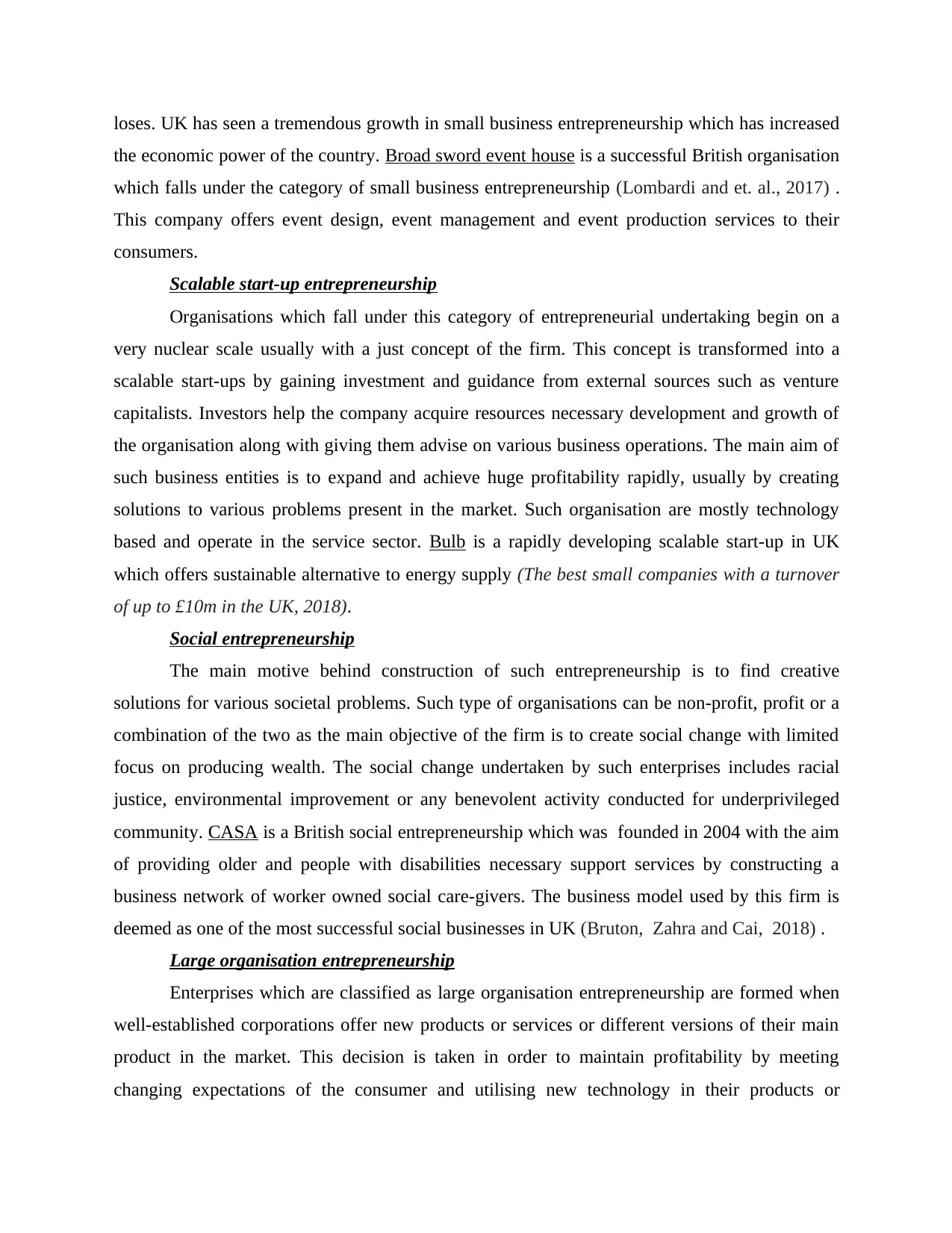
loses. UK has seen a tremendous growth in small business entrepreneurship which has increased
the economic power of the country. Broad sword event house is a successful British organisation
which falls under the category of small business entrepreneurship (Lombardi and et. al., 2017) .
This company offers event design, event management and event production services to their
consumers.
Scalable start-up entrepreneurship
Organisations which fall under this category of entrepreneurial undertaking begin on a
very nuclear scale usually with a just concept of the firm. This concept is transformed into a
scalable start-ups by gaining investment and guidance from external sources such as venture
capitalists. Investors help the company acquire resources necessary development and growth of
the organisation along with giving them advise on various business operations. The main aim of
such business entities is to expand and achieve huge profitability rapidly, usually by creating
solutions to various problems present in the market. Such organisation are mostly technology
based and operate in the service sector. Bulb is a rapidly developing scalable start-up in UK
which offers sustainable alternative to energy supply (The best small companies with a turnover
of up to £10m in the UK, 2018).
Social entrepreneurship
The main motive behind construction of such entrepreneurship is to find creative
solutions for various societal problems. Such type of organisations can be non-profit, profit or a
combination of the two as the main objective of the firm is to create social change with limited
focus on producing wealth. The social change undertaken by such enterprises includes racial
justice, environmental improvement or any benevolent activity conducted for underprivileged
community. CASA is a British social entrepreneurship which was founded in 2004 with the aim
of providing older and people with disabilities necessary support services by constructing a
business network of worker owned social care-givers. The business model used by this firm is
deemed as one of the most successful social businesses in UK (Bruton, Zahra and Cai, 2018) .
Large organisation entrepreneurship
Enterprises which are classified as large organisation entrepreneurship are formed when
well-established corporations offer new products or services or different versions of their main
product in the market. This decision is taken in order to maintain profitability by meeting
changing expectations of the consumer and utilising new technology in their products or
the economic power of the country. Broad sword event house is a successful British organisation
which falls under the category of small business entrepreneurship (Lombardi and et. al., 2017) .
This company offers event design, event management and event production services to their
consumers.
Scalable start-up entrepreneurship
Organisations which fall under this category of entrepreneurial undertaking begin on a
very nuclear scale usually with a just concept of the firm. This concept is transformed into a
scalable start-ups by gaining investment and guidance from external sources such as venture
capitalists. Investors help the company acquire resources necessary development and growth of
the organisation along with giving them advise on various business operations. The main aim of
such business entities is to expand and achieve huge profitability rapidly, usually by creating
solutions to various problems present in the market. Such organisation are mostly technology
based and operate in the service sector. Bulb is a rapidly developing scalable start-up in UK
which offers sustainable alternative to energy supply (The best small companies with a turnover
of up to £10m in the UK, 2018).
Social entrepreneurship
The main motive behind construction of such entrepreneurship is to find creative
solutions for various societal problems. Such type of organisations can be non-profit, profit or a
combination of the two as the main objective of the firm is to create social change with limited
focus on producing wealth. The social change undertaken by such enterprises includes racial
justice, environmental improvement or any benevolent activity conducted for underprivileged
community. CASA is a British social entrepreneurship which was founded in 2004 with the aim
of providing older and people with disabilities necessary support services by constructing a
business network of worker owned social care-givers. The business model used by this firm is
deemed as one of the most successful social businesses in UK (Bruton, Zahra and Cai, 2018) .
Large organisation entrepreneurship
Enterprises which are classified as large organisation entrepreneurship are formed when
well-established corporations offer new products or services or different versions of their main
product in the market. This decision is taken in order to maintain profitability by meeting
changing expectations of the consumer and utilising new technology in their products or
Paraphrase This Document
Need a fresh take? Get an instant paraphrase of this document with our AI Paraphraser
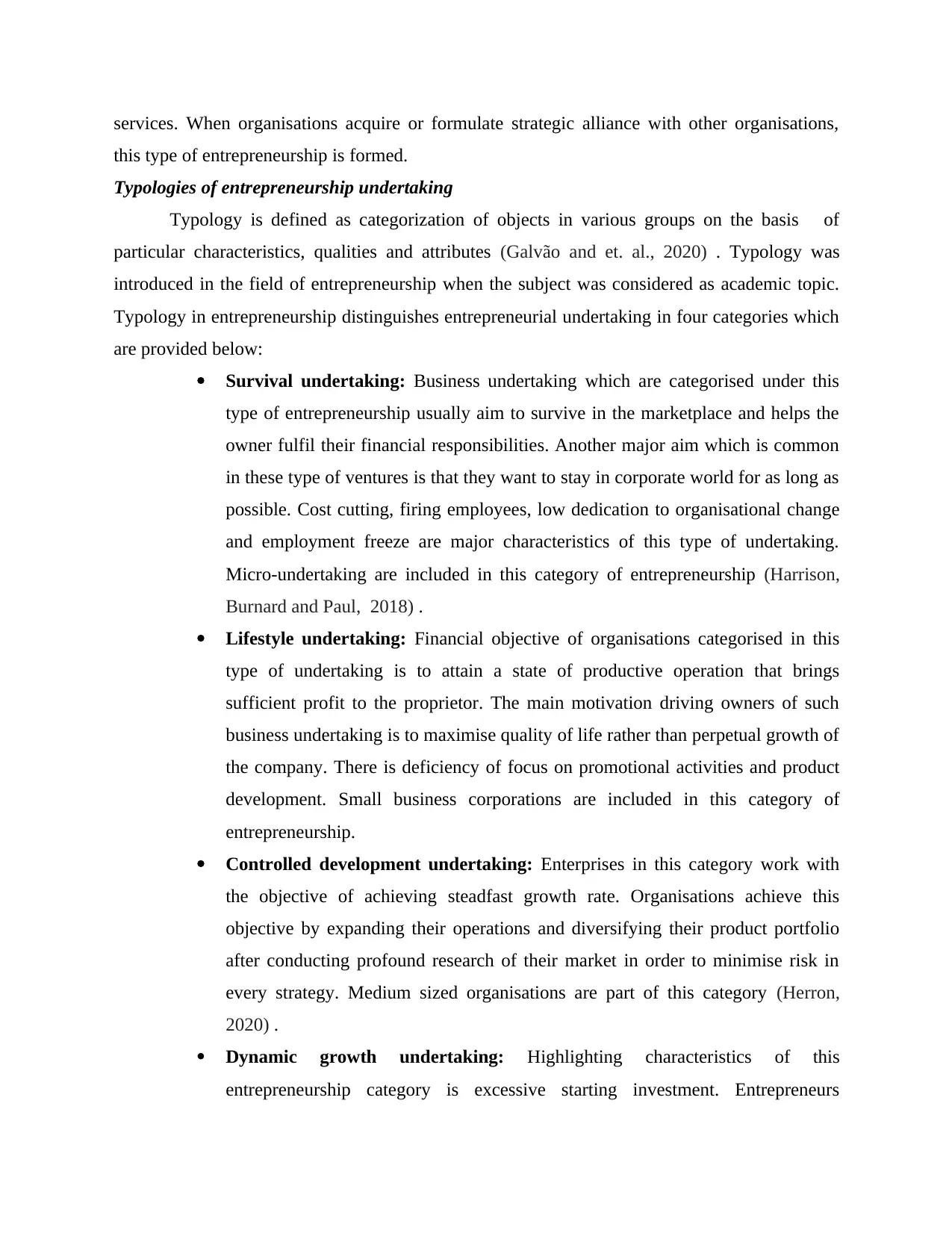
services. When organisations acquire or formulate strategic alliance with other organisations,
this type of entrepreneurship is formed.
Typologies of entrepreneurship undertaking
Typology is defined as categorization of objects in various groups on the basis of
particular characteristics, qualities and attributes (Galvão and et. al., 2020) . Typology was
introduced in the field of entrepreneurship when the subject was considered as academic topic.
Typology in entrepreneurship distinguishes entrepreneurial undertaking in four categories which
are provided below:
Survival undertaking: Business undertaking which are categorised under this
type of entrepreneurship usually aim to survive in the marketplace and helps the
owner fulfil their financial responsibilities. Another major aim which is common
in these type of ventures is that they want to stay in corporate world for as long as
possible. Cost cutting, firing employees, low dedication to organisational change
and employment freeze are major characteristics of this type of undertaking.
Micro-undertaking are included in this category of entrepreneurship (Harrison,
Burnard and Paul, 2018) .
Lifestyle undertaking: Financial objective of organisations categorised in this
type of undertaking is to attain a state of productive operation that brings
sufficient profit to the proprietor. The main motivation driving owners of such
business undertaking is to maximise quality of life rather than perpetual growth of
the company. There is deficiency of focus on promotional activities and product
development. Small business corporations are included in this category of
entrepreneurship.
Controlled development undertaking: Enterprises in this category work with
the objective of achieving steadfast growth rate. Organisations achieve this
objective by expanding their operations and diversifying their product portfolio
after conducting profound research of their market in order to minimise risk in
every strategy. Medium sized organisations are part of this category (Herron,
2020) .
Dynamic growth undertaking: Highlighting characteristics of this
entrepreneurship category is excessive starting investment. Entrepreneurs
this type of entrepreneurship is formed.
Typologies of entrepreneurship undertaking
Typology is defined as categorization of objects in various groups on the basis of
particular characteristics, qualities and attributes (Galvão and et. al., 2020) . Typology was
introduced in the field of entrepreneurship when the subject was considered as academic topic.
Typology in entrepreneurship distinguishes entrepreneurial undertaking in four categories which
are provided below:
Survival undertaking: Business undertaking which are categorised under this
type of entrepreneurship usually aim to survive in the marketplace and helps the
owner fulfil their financial responsibilities. Another major aim which is common
in these type of ventures is that they want to stay in corporate world for as long as
possible. Cost cutting, firing employees, low dedication to organisational change
and employment freeze are major characteristics of this type of undertaking.
Micro-undertaking are included in this category of entrepreneurship (Harrison,
Burnard and Paul, 2018) .
Lifestyle undertaking: Financial objective of organisations categorised in this
type of undertaking is to attain a state of productive operation that brings
sufficient profit to the proprietor. The main motivation driving owners of such
business undertaking is to maximise quality of life rather than perpetual growth of
the company. There is deficiency of focus on promotional activities and product
development. Small business corporations are included in this category of
entrepreneurship.
Controlled development undertaking: Enterprises in this category work with
the objective of achieving steadfast growth rate. Organisations achieve this
objective by expanding their operations and diversifying their product portfolio
after conducting profound research of their market in order to minimise risk in
every strategy. Medium sized organisations are part of this category (Herron,
2020) .
Dynamic growth undertaking: Highlighting characteristics of this
entrepreneurship category is excessive starting investment. Entrepreneurs
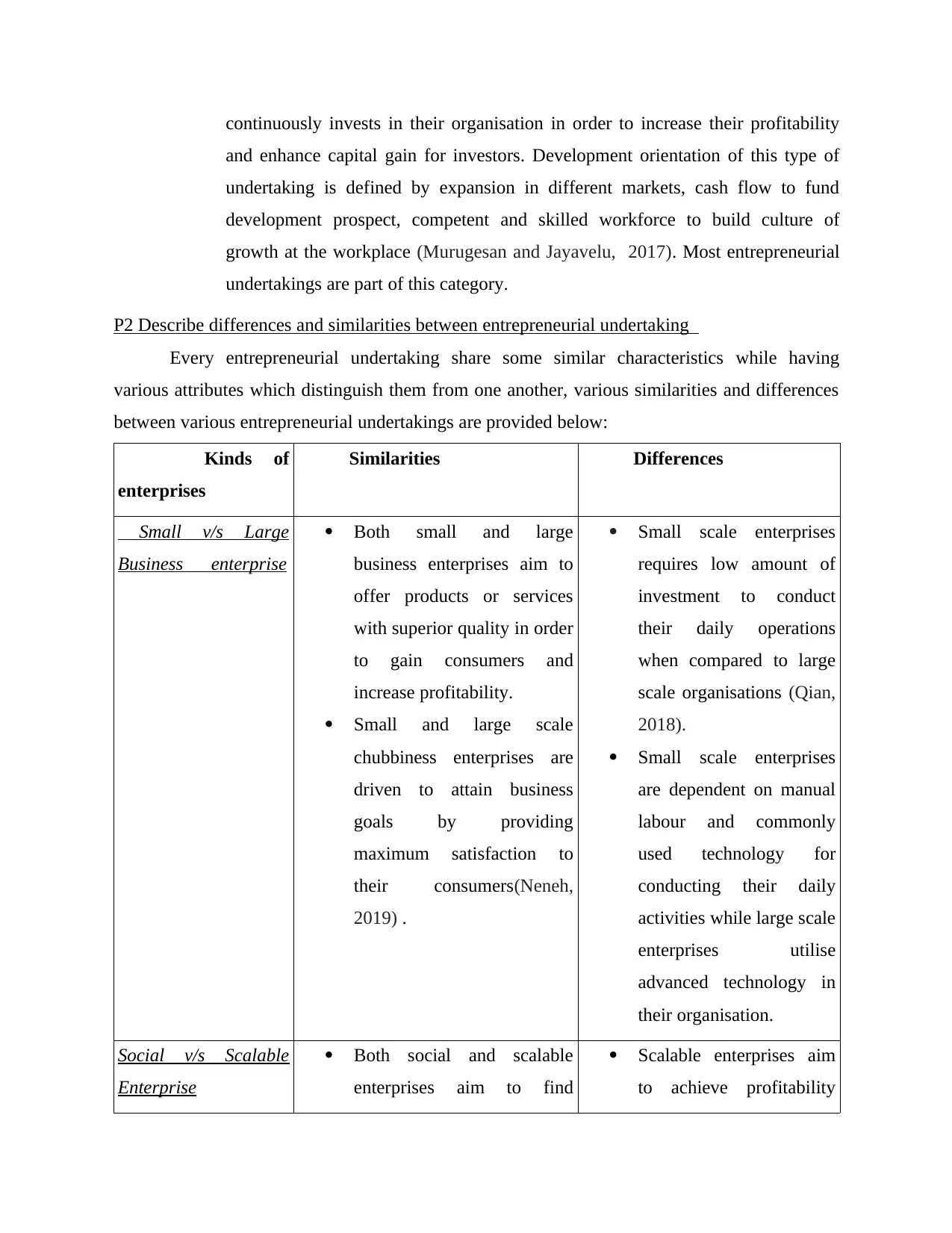
continuously invests in their organisation in order to increase their profitability
and enhance capital gain for investors. Development orientation of this type of
undertaking is defined by expansion in different markets, cash flow to fund
development prospect, competent and skilled workforce to build culture of
growth at the workplace (Murugesan and Jayavelu, 2017). Most entrepreneurial
undertakings are part of this category.
P2 Describe differences and similarities between entrepreneurial undertaking
Every entrepreneurial undertaking share some similar characteristics while having
various attributes which distinguish them from one another, various similarities and differences
between various entrepreneurial undertakings are provided below:
Kinds of
enterprises
Similarities Differences
Small v/s Large
Business enterprise
Both small and large
business enterprises aim to
offer products or services
with superior quality in order
to gain consumers and
increase profitability.
Small and large scale
chubbiness enterprises are
driven to attain business
goals by providing
maximum satisfaction to
their consumers(Neneh,
2019) .
Small scale enterprises
requires low amount of
investment to conduct
their daily operations
when compared to large
scale organisations (Qian,
2018).
Small scale enterprises
are dependent on manual
labour and commonly
used technology for
conducting their daily
activities while large scale
enterprises utilise
advanced technology in
their organisation.
Social v/s Scalable
Enterprise
Both social and scalable
enterprises aim to find
Scalable enterprises aim
to achieve profitability
and enhance capital gain for investors. Development orientation of this type of
undertaking is defined by expansion in different markets, cash flow to fund
development prospect, competent and skilled workforce to build culture of
growth at the workplace (Murugesan and Jayavelu, 2017). Most entrepreneurial
undertakings are part of this category.
P2 Describe differences and similarities between entrepreneurial undertaking
Every entrepreneurial undertaking share some similar characteristics while having
various attributes which distinguish them from one another, various similarities and differences
between various entrepreneurial undertakings are provided below:
Kinds of
enterprises
Similarities Differences
Small v/s Large
Business enterprise
Both small and large
business enterprises aim to
offer products or services
with superior quality in order
to gain consumers and
increase profitability.
Small and large scale
chubbiness enterprises are
driven to attain business
goals by providing
maximum satisfaction to
their consumers(Neneh,
2019) .
Small scale enterprises
requires low amount of
investment to conduct
their daily operations
when compared to large
scale organisations (Qian,
2018).
Small scale enterprises
are dependent on manual
labour and commonly
used technology for
conducting their daily
activities while large scale
enterprises utilise
advanced technology in
their organisation.
Social v/s Scalable
Enterprise
Both social and scalable
enterprises aim to find
Scalable enterprises aim
to achieve profitability
⊘ This is a preview!⊘
Do you want full access?
Subscribe today to unlock all pages.

Trusted by 1+ million students worldwide

effective and creative
solutions for various issues
in the marketplace and
society (Shu, Ren and
Zheng, 2018).
Both social and scalable
enterprises are enterprises
invest in ideas which help
the society eliminate various
issues.
through their daily
operations while main
motive of social
enterprises is societal
benefit with profits being
secondary (Julien,
2018) .
Scalable enterprises are
formed for solving needs
of huge population by
offering creative products
while social enterprise
focus on eliminating
societal issues for
specific communities.
Lifestyle v/s
survival
Entrepreneurial
undertaking
Both lifestyle and survival
enterprises conduct business
with the aim of providing
their owners sufficient
financial aids (Su, Zhai and
Karlsson, 2017) .
Lifestyle entrepreneurial
undertaking is formed out
of commitment for certain
concept and field of
business while survival
entrepreneurial
undertaking are formed to
stay in the corporate
world for as long as
possible.
TASK 2
P3 Understand and asses relevant information and statistical data to depict impact of small and
micro organisations on the economy
It is determined that small enterprises play a huge role in economic development of UK.
Various business activities conducted by such organisations contributions hugely to financial
solutions for various issues
in the marketplace and
society (Shu, Ren and
Zheng, 2018).
Both social and scalable
enterprises are enterprises
invest in ideas which help
the society eliminate various
issues.
through their daily
operations while main
motive of social
enterprises is societal
benefit with profits being
secondary (Julien,
2018) .
Scalable enterprises are
formed for solving needs
of huge population by
offering creative products
while social enterprise
focus on eliminating
societal issues for
specific communities.
Lifestyle v/s
survival
Entrepreneurial
undertaking
Both lifestyle and survival
enterprises conduct business
with the aim of providing
their owners sufficient
financial aids (Su, Zhai and
Karlsson, 2017) .
Lifestyle entrepreneurial
undertaking is formed out
of commitment for certain
concept and field of
business while survival
entrepreneurial
undertaking are formed to
stay in the corporate
world for as long as
possible.
TASK 2
P3 Understand and asses relevant information and statistical data to depict impact of small and
micro organisations on the economy
It is determined that small enterprises play a huge role in economic development of UK.
Various business activities conducted by such organisations contributions hugely to financial
Paraphrase This Document
Need a fresh take? Get an instant paraphrase of this document with our AI Paraphraser
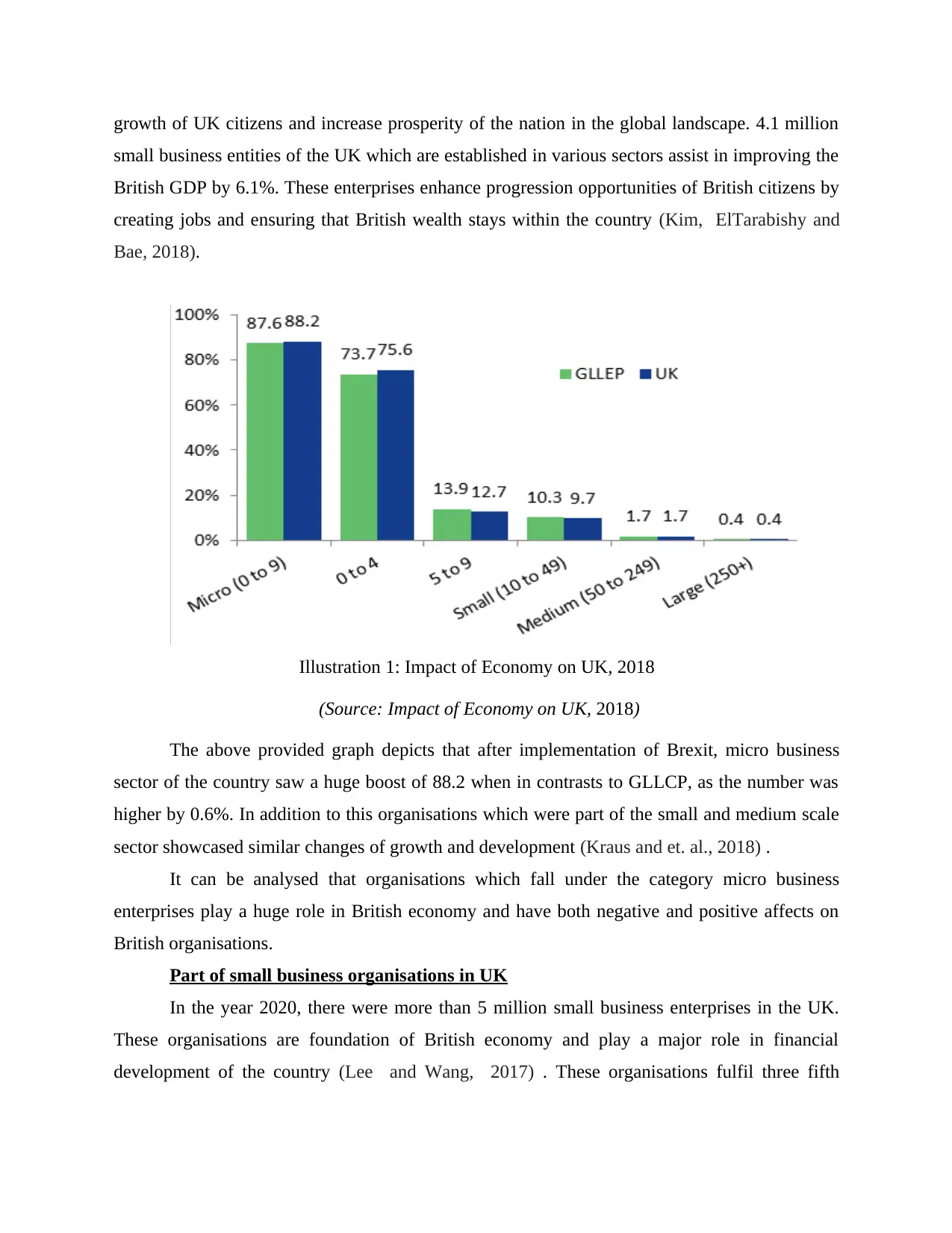
growth of UK citizens and increase prosperity of the nation in the global landscape. 4.1 million
small business entities of the UK which are established in various sectors assist in improving the
British GDP by 6.1%. These enterprises enhance progression opportunities of British citizens by
creating jobs and ensuring that British wealth stays within the country (Kim, ElTarabishy and
Bae, 2018).
Illustration 1: Impact of Economy on UK, 2018
(Source: Impact of Economy on UK, 2018)
The above provided graph depicts that after implementation of Brexit, micro business
sector of the country saw a huge boost of 88.2 when in contrasts to GLLCP, as the number was
higher by 0.6%. In addition to this organisations which were part of the small and medium scale
sector showcased similar changes of growth and development (Kraus and et. al., 2018) .
It can be analysed that organisations which fall under the category micro business
enterprises play a huge role in British economy and have both negative and positive affects on
British organisations.
Part of small business organisations in UK
In the year 2020, there were more than 5 million small business enterprises in the UK.
These organisations are foundation of British economy and play a major role in financial
development of the country (Lee and Wang, 2017) . These organisations fulfil three fifth
small business entities of the UK which are established in various sectors assist in improving the
British GDP by 6.1%. These enterprises enhance progression opportunities of British citizens by
creating jobs and ensuring that British wealth stays within the country (Kim, ElTarabishy and
Bae, 2018).
Illustration 1: Impact of Economy on UK, 2018
(Source: Impact of Economy on UK, 2018)
The above provided graph depicts that after implementation of Brexit, micro business
sector of the country saw a huge boost of 88.2 when in contrasts to GLLCP, as the number was
higher by 0.6%. In addition to this organisations which were part of the small and medium scale
sector showcased similar changes of growth and development (Kraus and et. al., 2018) .
It can be analysed that organisations which fall under the category micro business
enterprises play a huge role in British economy and have both negative and positive affects on
British organisations.
Part of small business organisations in UK
In the year 2020, there were more than 5 million small business enterprises in the UK.
These organisations are foundation of British economy and play a major role in financial
development of the country (Lee and Wang, 2017) . These organisations fulfil three fifth

employment needs in the country and are reason for half of turnover in British private sector.
Various contributions of such organisation to British economy are provided below:
Fulfil employment needs: Small and medium scale enterprises recruit more than 16.3
million people in Britain which fulfils 60% employment needs in Britain. Various
small businesses have generated 2 million jobs in UK which has helped in reducing
unemployment rates and secure beneficial financial position for the nation (Li and et.
al., 2018) .
Enhance innovation: Local small business enterprises help enhance innovation within
the country by providing creative solutions to various issues present in the marketplace
and the overall British society. Various enterprises help the citizens of the country
develop skills needed to grow continuously and maintain stable economic growth rate
of the nation.
The British government needs to implement policies which ensure continuous growth small and
micro organisations as they are major contributors to financial growth and economic stability of
the nation (Urban and Chantson, 2019) .
P4 Significance of small enterprises and start up firms to the development of social economy
Enforcement of Brexit which involved separation of UK from the EU resulted in sudden
decrease in financial stability of the company and created slow economic environment in the
nation. The British government needs to enhance progress of the small and medium business
industry so that they can tackle such economic downturn and return to stable economic state.
This is because Small and micro business enterprises not only provide employment
opportunity to a large portion of British citizens but also bring positive improvement to the GDP
of the nation. The small business sector is the maintains 6% of UK GDP. The British economy
will become prosperous as a result of developing small and micro business sector. This is due to
the fact that small and micro business enterprise will increase per capita income of British
citizens (What Are SMEs & Why Are They So Important for the UK Economy?, 2019). The
British government needs to help young and commuted entrepreneurs build their business
organisations and protect them from aggressive competition from international corporations so
they can grow and help keep British wealth in the country.
Various contributions of such organisation to British economy are provided below:
Fulfil employment needs: Small and medium scale enterprises recruit more than 16.3
million people in Britain which fulfils 60% employment needs in Britain. Various
small businesses have generated 2 million jobs in UK which has helped in reducing
unemployment rates and secure beneficial financial position for the nation (Li and et.
al., 2018) .
Enhance innovation: Local small business enterprises help enhance innovation within
the country by providing creative solutions to various issues present in the marketplace
and the overall British society. Various enterprises help the citizens of the country
develop skills needed to grow continuously and maintain stable economic growth rate
of the nation.
The British government needs to implement policies which ensure continuous growth small and
micro organisations as they are major contributors to financial growth and economic stability of
the nation (Urban and Chantson, 2019) .
P4 Significance of small enterprises and start up firms to the development of social economy
Enforcement of Brexit which involved separation of UK from the EU resulted in sudden
decrease in financial stability of the company and created slow economic environment in the
nation. The British government needs to enhance progress of the small and medium business
industry so that they can tackle such economic downturn and return to stable economic state.
This is because Small and micro business enterprises not only provide employment
opportunity to a large portion of British citizens but also bring positive improvement to the GDP
of the nation. The small business sector is the maintains 6% of UK GDP. The British economy
will become prosperous as a result of developing small and micro business sector. This is due to
the fact that small and micro business enterprise will increase per capita income of British
citizens (What Are SMEs & Why Are They So Important for the UK Economy?, 2019). The
British government needs to help young and commuted entrepreneurs build their business
organisations and protect them from aggressive competition from international corporations so
they can grow and help keep British wealth in the country.
⊘ This is a preview!⊘
Do you want full access?
Subscribe today to unlock all pages.

Trusted by 1+ million students worldwide
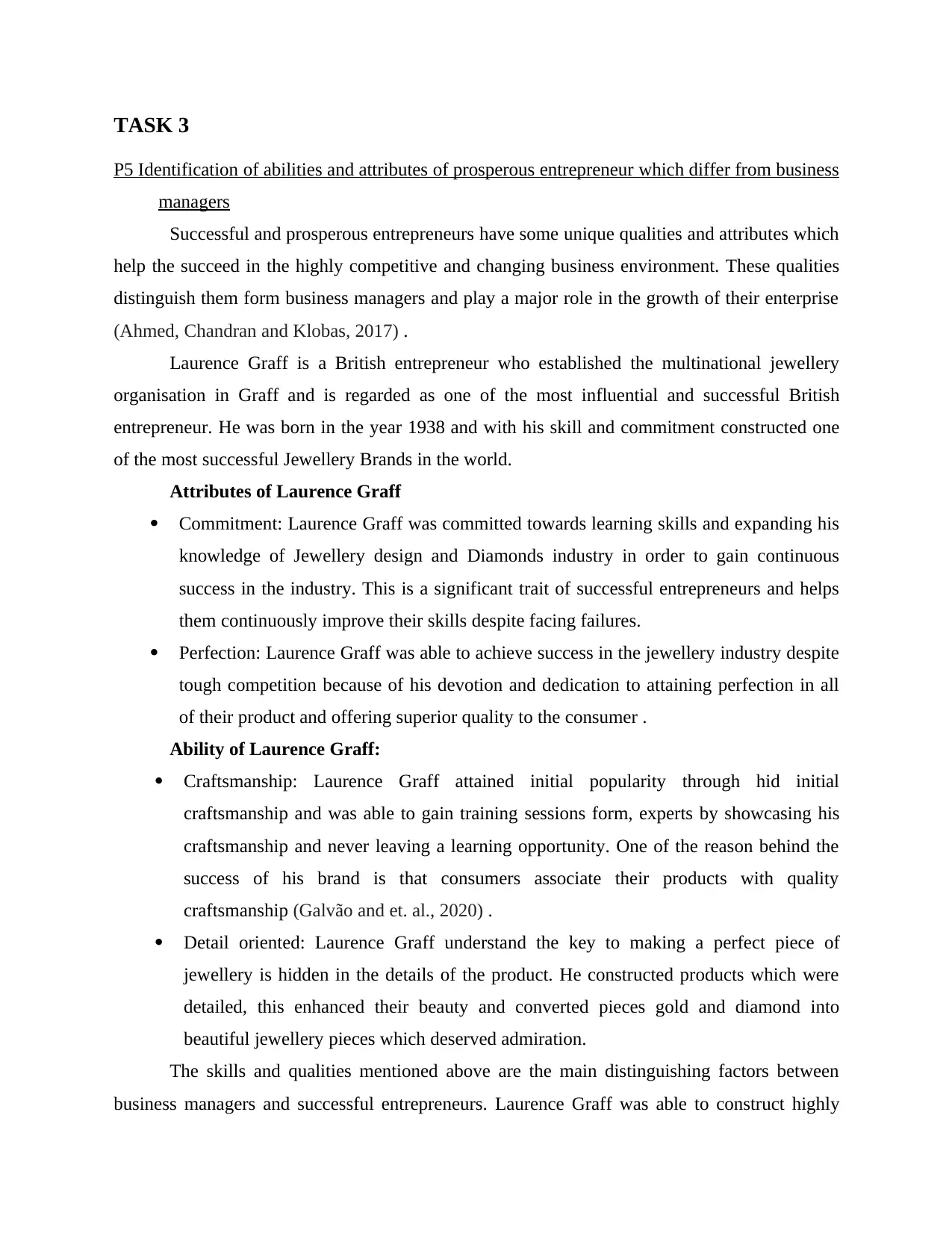
TASK 3
P5 Identification of abilities and attributes of prosperous entrepreneur which differ from business
managers
Successful and prosperous entrepreneurs have some unique qualities and attributes which
help the succeed in the highly competitive and changing business environment. These qualities
distinguish them form business managers and play a major role in the growth of their enterprise
(Ahmed, Chandran and Klobas, 2017) .
Laurence Graff is a British entrepreneur who established the multinational jewellery
organisation in Graff and is regarded as one of the most influential and successful British
entrepreneur. He was born in the year 1938 and with his skill and commitment constructed one
of the most successful Jewellery Brands in the world.
Attributes of Laurence Graff
Commitment: Laurence Graff was committed towards learning skills and expanding his
knowledge of Jewellery design and Diamonds industry in order to gain continuous
success in the industry. This is a significant trait of successful entrepreneurs and helps
them continuously improve their skills despite facing failures.
Perfection: Laurence Graff was able to achieve success in the jewellery industry despite
tough competition because of his devotion and dedication to attaining perfection in all
of their product and offering superior quality to the consumer .
Ability of Laurence Graff:
Craftsmanship: Laurence Graff attained initial popularity through hid initial
craftsmanship and was able to gain training sessions form, experts by showcasing his
craftsmanship and never leaving a learning opportunity. One of the reason behind the
success of his brand is that consumers associate their products with quality
craftsmanship (Galvão and et. al., 2020) .
Detail oriented: Laurence Graff understand the key to making a perfect piece of
jewellery is hidden in the details of the product. He constructed products which were
detailed, this enhanced their beauty and converted pieces gold and diamond into
beautiful jewellery pieces which deserved admiration.
The skills and qualities mentioned above are the main distinguishing factors between
business managers and successful entrepreneurs. Laurence Graff was able to construct highly
P5 Identification of abilities and attributes of prosperous entrepreneur which differ from business
managers
Successful and prosperous entrepreneurs have some unique qualities and attributes which
help the succeed in the highly competitive and changing business environment. These qualities
distinguish them form business managers and play a major role in the growth of their enterprise
(Ahmed, Chandran and Klobas, 2017) .
Laurence Graff is a British entrepreneur who established the multinational jewellery
organisation in Graff and is regarded as one of the most influential and successful British
entrepreneur. He was born in the year 1938 and with his skill and commitment constructed one
of the most successful Jewellery Brands in the world.
Attributes of Laurence Graff
Commitment: Laurence Graff was committed towards learning skills and expanding his
knowledge of Jewellery design and Diamonds industry in order to gain continuous
success in the industry. This is a significant trait of successful entrepreneurs and helps
them continuously improve their skills despite facing failures.
Perfection: Laurence Graff was able to achieve success in the jewellery industry despite
tough competition because of his devotion and dedication to attaining perfection in all
of their product and offering superior quality to the consumer .
Ability of Laurence Graff:
Craftsmanship: Laurence Graff attained initial popularity through hid initial
craftsmanship and was able to gain training sessions form, experts by showcasing his
craftsmanship and never leaving a learning opportunity. One of the reason behind the
success of his brand is that consumers associate their products with quality
craftsmanship (Galvão and et. al., 2020) .
Detail oriented: Laurence Graff understand the key to making a perfect piece of
jewellery is hidden in the details of the product. He constructed products which were
detailed, this enhanced their beauty and converted pieces gold and diamond into
beautiful jewellery pieces which deserved admiration.
The skills and qualities mentioned above are the main distinguishing factors between
business managers and successful entrepreneurs. Laurence Graff was able to construct highly
Paraphrase This Document
Need a fresh take? Get an instant paraphrase of this document with our AI Paraphraser
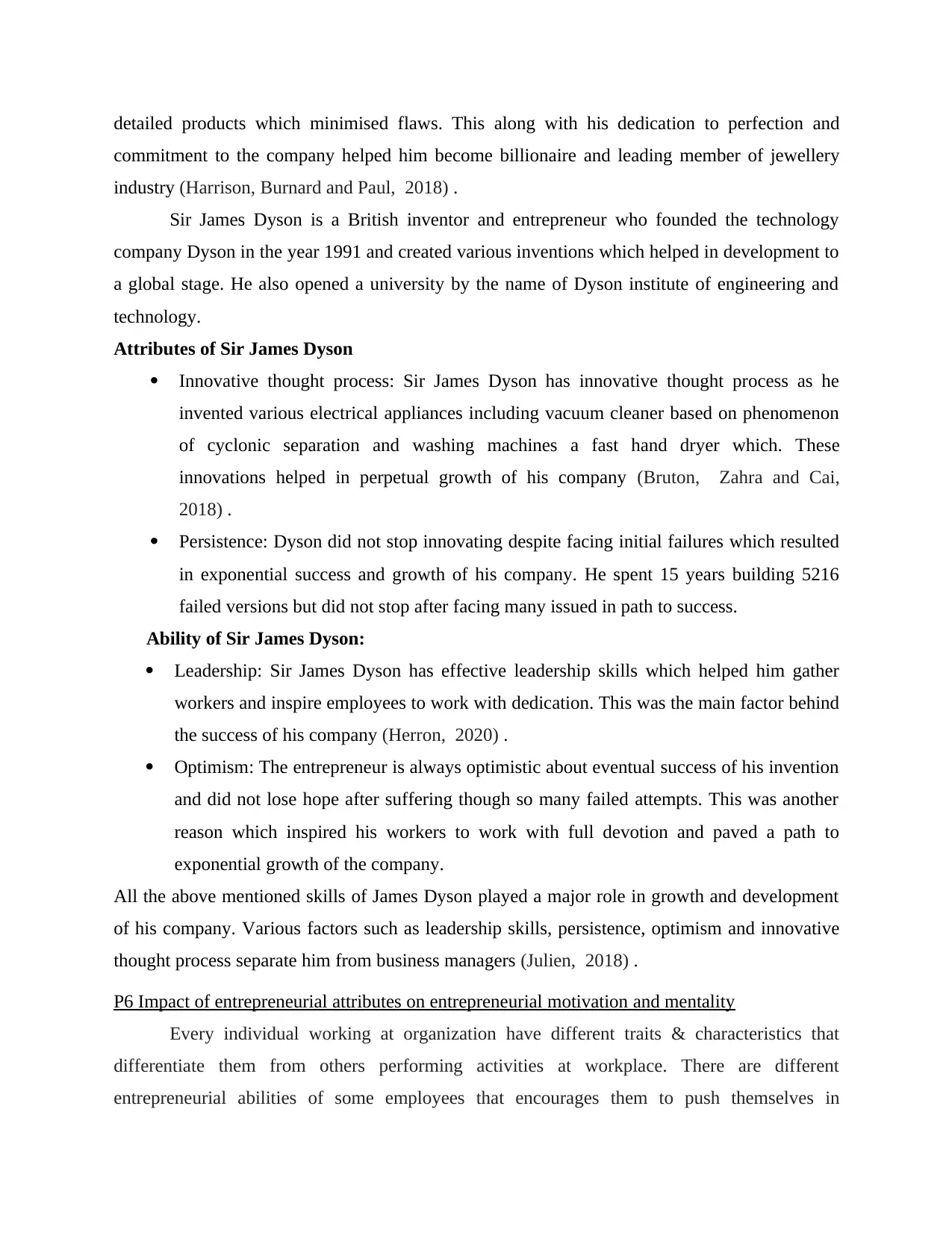
detailed products which minimised flaws. This along with his dedication to perfection and
commitment to the company helped him become billionaire and leading member of jewellery
industry (Harrison, Burnard and Paul, 2018) .
Sir James Dyson is a British inventor and entrepreneur who founded the technology
company Dyson in the year 1991 and created various inventions which helped in development to
a global stage. He also opened a university by the name of Dyson institute of engineering and
technology.
Attributes of Sir James Dyson
Innovative thought process: Sir James Dyson has innovative thought process as he
invented various electrical appliances including vacuum cleaner based on phenomenon
of cyclonic separation and washing machines a fast hand dryer which. These
innovations helped in perpetual growth of his company (Bruton, Zahra and Cai,
2018) .
Persistence: Dyson did not stop innovating despite facing initial failures which resulted
in exponential success and growth of his company. He spent 15 years building 5216
failed versions but did not stop after facing many issued in path to success.
Ability of Sir James Dyson:
Leadership: Sir James Dyson has effective leadership skills which helped him gather
workers and inspire employees to work with dedication. This was the main factor behind
the success of his company (Herron, 2020) .
Optimism: The entrepreneur is always optimistic about eventual success of his invention
and did not lose hope after suffering though so many failed attempts. This was another
reason which inspired his workers to work with full devotion and paved a path to
exponential growth of the company.
All the above mentioned skills of James Dyson played a major role in growth and development
of his company. Various factors such as leadership skills, persistence, optimism and innovative
thought process separate him from business managers (Julien, 2018) .
P6 Impact of entrepreneurial attributes on entrepreneurial motivation and mentality
Every individual working at organization have different traits & characteristics that
differentiate them from others performing activities at workplace. There are different
entrepreneurial abilities of some employees that encourages them to push themselves in
commitment to the company helped him become billionaire and leading member of jewellery
industry (Harrison, Burnard and Paul, 2018) .
Sir James Dyson is a British inventor and entrepreneur who founded the technology
company Dyson in the year 1991 and created various inventions which helped in development to
a global stage. He also opened a university by the name of Dyson institute of engineering and
technology.
Attributes of Sir James Dyson
Innovative thought process: Sir James Dyson has innovative thought process as he
invented various electrical appliances including vacuum cleaner based on phenomenon
of cyclonic separation and washing machines a fast hand dryer which. These
innovations helped in perpetual growth of his company (Bruton, Zahra and Cai,
2018) .
Persistence: Dyson did not stop innovating despite facing initial failures which resulted
in exponential success and growth of his company. He spent 15 years building 5216
failed versions but did not stop after facing many issued in path to success.
Ability of Sir James Dyson:
Leadership: Sir James Dyson has effective leadership skills which helped him gather
workers and inspire employees to work with dedication. This was the main factor behind
the success of his company (Herron, 2020) .
Optimism: The entrepreneur is always optimistic about eventual success of his invention
and did not lose hope after suffering though so many failed attempts. This was another
reason which inspired his workers to work with full devotion and paved a path to
exponential growth of the company.
All the above mentioned skills of James Dyson played a major role in growth and development
of his company. Various factors such as leadership skills, persistence, optimism and innovative
thought process separate him from business managers (Julien, 2018) .
P6 Impact of entrepreneurial attributes on entrepreneurial motivation and mentality
Every individual working at organization have different traits & characteristics that
differentiate them from others performing activities at workplace. There are different
entrepreneurial abilities of some employees that encourages them to push themselves in
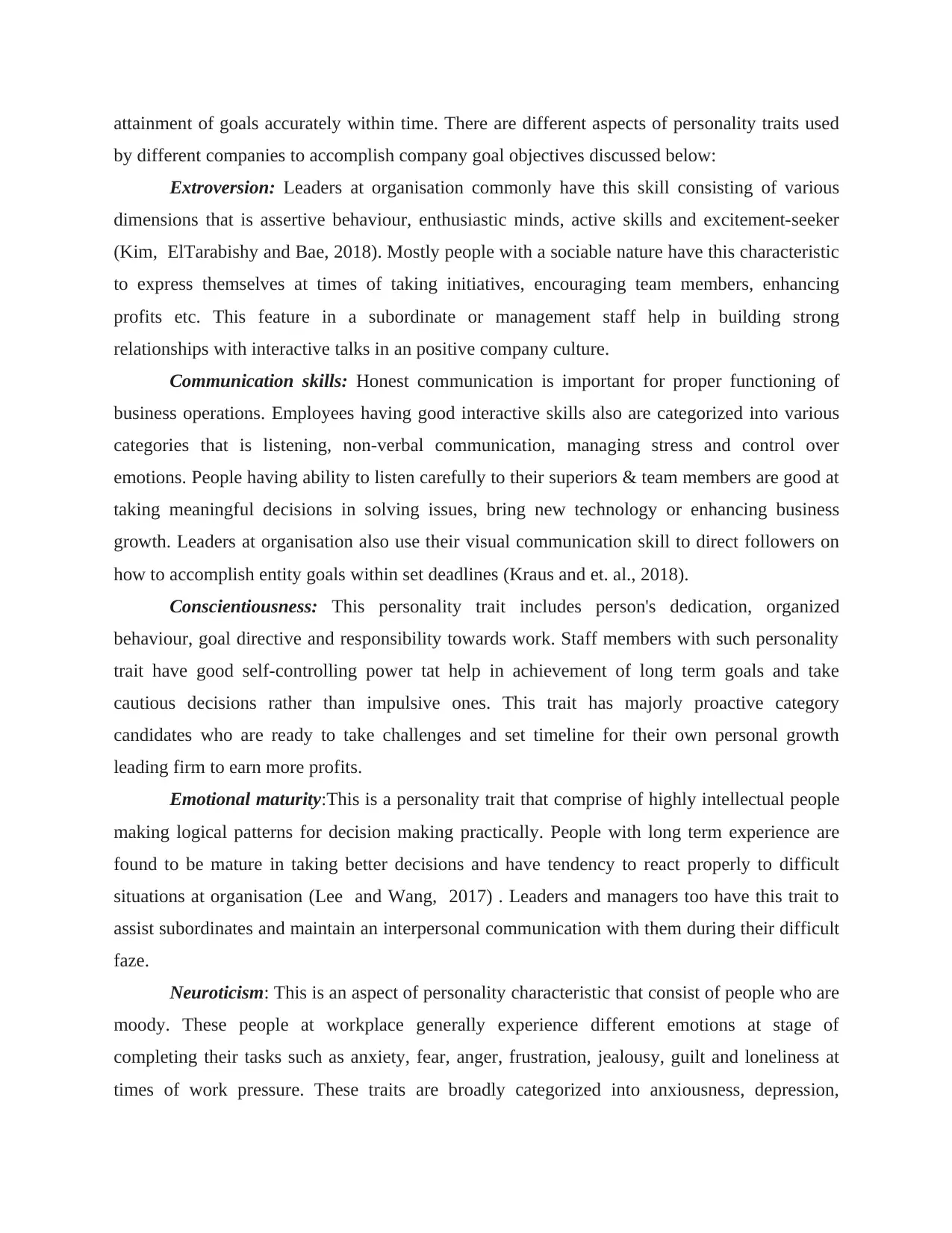
attainment of goals accurately within time. There are different aspects of personality traits used
by different companies to accomplish company goal objectives discussed below:
Extroversion: Leaders at organisation commonly have this skill consisting of various
dimensions that is assertive behaviour, enthusiastic minds, active skills and excitement-seeker
(Kim, ElTarabishy and Bae, 2018). Mostly people with a sociable nature have this characteristic
to express themselves at times of taking initiatives, encouraging team members, enhancing
profits etc. This feature in a subordinate or management staff help in building strong
relationships with interactive talks in an positive company culture.
Communication skills: Honest communication is important for proper functioning of
business operations. Employees having good interactive skills also are categorized into various
categories that is listening, non-verbal communication, managing stress and control over
emotions. People having ability to listen carefully to their superiors & team members are good at
taking meaningful decisions in solving issues, bring new technology or enhancing business
growth. Leaders at organisation also use their visual communication skill to direct followers on
how to accomplish entity goals within set deadlines (Kraus and et. al., 2018).
Conscientiousness: This personality trait includes person's dedication, organized
behaviour, goal directive and responsibility towards work. Staff members with such personality
trait have good self-controlling power tat help in achievement of long term goals and take
cautious decisions rather than impulsive ones. This trait has majorly proactive category
candidates who are ready to take challenges and set timeline for their own personal growth
leading firm to earn more profits.
Emotional maturity:This is a personality trait that comprise of highly intellectual people
making logical patterns for decision making practically. People with long term experience are
found to be mature in taking better decisions and have tendency to react properly to difficult
situations at organisation (Lee and Wang, 2017) . Leaders and managers too have this trait to
assist subordinates and maintain an interpersonal communication with them during their difficult
faze.
Neuroticism: This is an aspect of personality characteristic that consist of people who are
moody. These people at workplace generally experience different emotions at stage of
completing their tasks such as anxiety, fear, anger, frustration, jealousy, guilt and loneliness at
times of work pressure. These traits are broadly categorized into anxiousness, depression,
by different companies to accomplish company goal objectives discussed below:
Extroversion: Leaders at organisation commonly have this skill consisting of various
dimensions that is assertive behaviour, enthusiastic minds, active skills and excitement-seeker
(Kim, ElTarabishy and Bae, 2018). Mostly people with a sociable nature have this characteristic
to express themselves at times of taking initiatives, encouraging team members, enhancing
profits etc. This feature in a subordinate or management staff help in building strong
relationships with interactive talks in an positive company culture.
Communication skills: Honest communication is important for proper functioning of
business operations. Employees having good interactive skills also are categorized into various
categories that is listening, non-verbal communication, managing stress and control over
emotions. People having ability to listen carefully to their superiors & team members are good at
taking meaningful decisions in solving issues, bring new technology or enhancing business
growth. Leaders at organisation also use their visual communication skill to direct followers on
how to accomplish entity goals within set deadlines (Kraus and et. al., 2018).
Conscientiousness: This personality trait includes person's dedication, organized
behaviour, goal directive and responsibility towards work. Staff members with such personality
trait have good self-controlling power tat help in achievement of long term goals and take
cautious decisions rather than impulsive ones. This trait has majorly proactive category
candidates who are ready to take challenges and set timeline for their own personal growth
leading firm to earn more profits.
Emotional maturity:This is a personality trait that comprise of highly intellectual people
making logical patterns for decision making practically. People with long term experience are
found to be mature in taking better decisions and have tendency to react properly to difficult
situations at organisation (Lee and Wang, 2017) . Leaders and managers too have this trait to
assist subordinates and maintain an interpersonal communication with them during their difficult
faze.
Neuroticism: This is an aspect of personality characteristic that consist of people who are
moody. These people at workplace generally experience different emotions at stage of
completing their tasks such as anxiety, fear, anger, frustration, jealousy, guilt and loneliness at
times of work pressure. These traits are broadly categorized into anxiousness, depression,
⊘ This is a preview!⊘
Do you want full access?
Subscribe today to unlock all pages.

Trusted by 1+ million students worldwide
1 out of 16
Related Documents
Your All-in-One AI-Powered Toolkit for Academic Success.
+13062052269
info@desklib.com
Available 24*7 on WhatsApp / Email
![[object Object]](/_next/static/media/star-bottom.7253800d.svg)
Unlock your academic potential
Copyright © 2020–2025 A2Z Services. All Rights Reserved. Developed and managed by ZUCOL.





